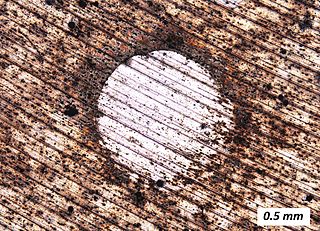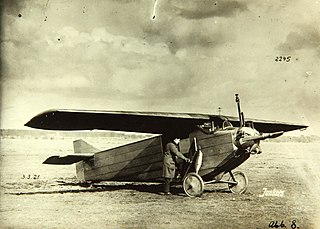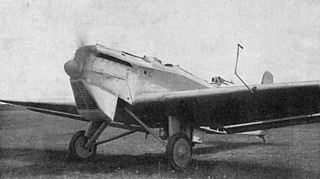
Duralumin is a trade name for one of the earliest types of age-hardenable aluminium–copper alloys. The term is a combination of Dürener and aluminium. Its use as a trade name is obsolete. Today the term mainly refers to aluminium-copper alloys, designated as the 2000 series by the international alloy designation system (IADS), as with 2014 and 2024 alloys used in airframe fabrication.

Junkers Flugzeug- und Motorenwerke AG more commonly Junkers, was a major German aircraft and aircraft engine manufacturer. It was founded in Dessau, Germany, in 1895 by Hugo Junkers, initially manufacturing boilers and radiators. During World War I and following the war, the company became famous for its pioneering all-metal aircraft. During World War II the company produced the German air force's planes, as well as piston and jet aircraft engines, albeit in the absence of its founder who had been removed by the Nazis in 1934.

Hugo Junkers was a German aircraft engineer and aircraft designer who pioneered the design of all-metal airplanes and flying wings. His company, Junkers Flugzeug- und Motorenwerke AG, was one of the mainstays of the German aircraft industry in the years between World War I and World War II. His multi-engined, all-metal passenger- and freight planes helped establish airlines in Germany and around the world.

The mechanical structure of an aircraft is known as the airframe. This structure is typically considered to include the fuselage, undercarriage, empennage and wings, and excludes the propulsion system.

The Junkers F 13 is the world's first all-metal transport aircraft, designed and produced by the German aircraft manufacturer Junkers.

The Junkers Ju 90 was a four-engined airliner and transport aircraft designed and produced by the German aircraft manufacturer Junkers.

The Fokker Eindecker fighters were a series of German World War I monoplane single-seat fighter aircraft designed by Dutch engineer Anthony Fokker. Developed in April 1915, the first Eindecker ("Monoplane") was the first purpose-built German fighter aircraft and the first aircraft to be fitted with a synchronization gear, enabling the pilot to fire a machine gun through the arc of the propeller without striking the blades. The Eindecker gave the German Army's Air Service (then the Fliegertruppen des deutschen Kaiserreiches) a degree of air superiority from July 1915 until early 1916. This period, during which Allied aviators regarded their poorly armed aircraft as "Fokker Fodder", became known as the "Fokker Scourge".

The Fokker E.III was the main variant of the Eindecker fighter aircraft of World War I. It entered service on the Western Front in December 1915 and was also supplied to Austria-Hungary and Turkey.

The Junkers A50 Junior is an all-metal sports plane designed and produced by the German aircraft manufacturer Junkers.

The Fokker V.1 was a small German sesquiplane experimental fighter prototype built in 1916 by the Fokker-Flugzeugwerke. Sporting a parasol wing, it was the first Fokker aircraft purportedly designed by Reinhold Platz—the respective roles played by Fokker himself, Platz, and possibly others in the conceptual design of Fokker airplanes are a matter of dispute among historians—and was an early experiment in cantilever wing construction, eliminating the bracing wires typical of aircraft design at the time, something that had already been achieved with metal materials in Hugo Junkers' own pioneering Junkers J 1 in 1915.

The Junkers J 1, nicknamed the Blechesel, was an experimental monoplane aircraft developed by Junkers. It was the first all-metal aircraft in the world. Manufactured early in the First World War, an era in which aircraft designers relied largely on fabric-covered wooden structures braced with wires, the J 1 was a revolutionary development in aircraft design, making extensive use of metal in its structure and in its outer surface.

The Junkers CL.I was a ground-attack aircraft developed in Germany during World War I. Its construction was undertaken by Junkers under the designation J 8 as proof of Hugo Junkers' belief in the monoplane, after his firm had been required by the Idflieg to submit a biplane as its entry in a competition to select a ground-attack aircraft.

The Junkers J 2 was the first all-metal aircraft intended as a dedicated military aircraft design, the first all-metal aircraft meant to be a fighter aircraft, and was the direct descendant of the pioneering J 1 all-metal aircraft technology demonstrator design of 1915.

The Junkers G 31 was an advanced tri-motor airliner designed and produced by the German aircraft manufacturer Junkers. It would be the first airliner operated by Deutsche Luft Hansa to feature a flight attendant.

The Junkers K 16 was a small airliner produced in Germany in the early 1920s. It was a conventional, high-wing cantilever monoplane of all-metal construction, equipped with fixed, tailwheel undercarriage. The pilot sat in an open cockpit, while the two passengers were provided with an enclosed cabin within the fuselage. Shortly after the prototype flew, aircraft production in Germany was brought to a complete halt by the Allies, and the K 16 was quickly evacuated to the Netherlands to avoid confiscation. There, it was stored by Fokker until the restrictions were relaxed and work recommenced at Junkers' Dessau factory in 1924. By this time, however, the airline niche that the tiny K 16 had been intended to fill no longer existed, and the small number that were produced were mostly sold to private owners. Junkers entered two K 16s in the 1925 Deutsche Rundflug, with one machine winning second place in the competition.

The Junkers S 36 was a twin-engine mail plane developed in Germany in the late 1920s that was further developed in Sweden as a multi-role military aircraft, albeit unsuccessfully, under the designation K 37. The design itself was a low-wing cantilever monoplane of largely conventional design, featuring twin tails and fixed, tailwheel undercarriage. Construction was metal throughout and skinned, in typical Junkers fashion, with corrugated duralumin. The engines were mounted in nacelles on the wings, and the crew was accommodated in three open cockpits, including one in the very nose of the aircraft.

The Junkers A 32 was a mail plane built in prototype form in Germany in the late 1920s, and later developed as a prototype reconnaissance-bomber under the designation K 39. The design was a conventional low-wing cantilever monoplane with fixed tailskid undercarriage. Construction was metal throughout, with corrugated duralumin skin. Three open cockpits were provided in tandem; the third seat intended from the outset to accommodate a tail gunner for a military version of the aircraft. In fact, the militarised version developed in Sweden by AB Flygindustri featured a fourth crew position as well, for a bombardier. This version featured twin machine guns built into the engine cowling, and a trainable machine gun for the tail gunner.

The Bristol M.R.1 was an experimental biplane with an aluminium monocoque fuselage and metal wings, produced by Bristol during the First World War. Two were built to government order.

The Junkers T 19, originally known as the J 19, was a single-engined parasol winged all-metal 2/3-seat aircraft built in Germany in the early 1920s for training and touring. Its construction was too expensive for commercial success and only three were built, one later finding use as an engine test-bed.
The Junkers J 29 was a two-seat, single-engined experimental training monoplane, built in Germany in 1925. Its significance is that it was the first aircraft to fly and test the Junkers Doppelflügel control surfaces used very successfully on the later Junkers Ju 52.



















